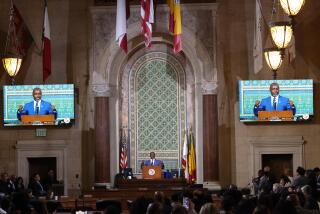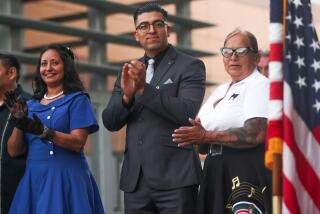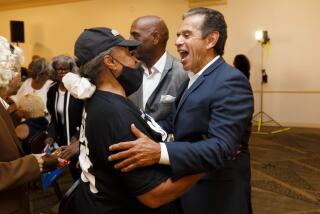He’s gotten our attention
Antonio Villaraigosa’s historic victory as the first Latino mayor in modern Los Angeles did more than signal the beginning of a new era at City Hall. Overnight, as political blogger Joe Scott put it, Villaraigosa became the “numero uno star in Latino national politics.”
Antonio fever is sure to reach a pitch Friday morning when the numero uno star is sworn in, but will Angelenos really care? This is a city, after all, that doesn’t generally give a fig about its chief executive and proved it by staying home in droves during the election. (Turnout in the May 17 election was a paltry 33.9% of registered voters.) Does anyone think Villaraigosa can really make a difference in their lives?
He can’t twitch his nose and make the perpetual rush hour on our freeways disappear. He can’t turn the public schools around (though he is making noises about trying). He probably can’t stop your job from being outsourced to India. “It doesn’t really matter who’s mayor,” said urban expert Joel Kotkin, who lives in Valley Village. “It’s almost that Villaraigosa is more exciting as an idea than as an individual.”
But a mayor does have power. He can fix your potholes, tidy the parks, hire new cops and help determine how public transit works (or whether it does). Perhaps most important, he might restore your optimism about this city. Look what clamping down on the armies of intimidating squeegee men did for former New York Mayor Rudolph W. Giuliani. This may be the most interesting aspect of the dawning Villaraigosa era: his ability to evoke in Angelenos a certain emotion, tied to the idea that we are on the brink of a historic new era, that the outgoing mayor couldn’t have tapped in a million years.
“I’ve lived under a lot of mayors, most memorably that stinker [Sam] Yorty, who was very divisive,” said poet and essayist Wanda Coleman, who recently moved to Lancaster, where the sounds of early morning trains evoke her South L.A. childhood. “When Watts exploded, Yorty said it wasn’t even part of the city of Los Angeles! That is the kind of mentality that has ruled Los Angeles for so long.” The initial euphoria over the election of the mayor who followed Yorty into office, Tom Bradley, soon waned, said Coleman, and she found him to be a disappointment. “Our first black mayor,” she said, “and yet he seemed ineffectual.”
When Coleman speaks of Villaraigosa, however, you can hear the hopefulness in her voice. “We have a new unifying principle here in this mayor,” she said. “I think he could probably mean a new foundation, a new unity. I’ve got my fingers crossed for that.”
Like Coleman, filmmaker Robert Greenwald, a Marina del Rey resident who has produced left-leaning documentaries about Fox News and the buildup to the war in Iraq, is feeling more optimistic about City Hall than he has in years. He was especially impressed by Villaraigosa’s work with hotel owners and union leaders to avert a hotel lockout earlier this month.
“I don’t think there’s anybody powerful enough to fix the traffic,” Greenwald said, “but the fact that Antonio has such energy and vision has already made a difference. And the fact that he stayed up all night and helped solve the hotel workers’ strike -- there was a jaunt in people’s steps the next day, an excitement that we’ve got somebody now who’s a real leader and who cares and who’s got ‘the vision thing.’ He represents a positive belief that things can be done to improve our city.”
The idea that the new mayor is capable of inspiring and motivating Angelenos crops up frequently in conversations with people who are engaged in local civic and cultural life. Deborah Borda, president of the Los Angeles Philharmonic Assn., has worked closely with the new mayor on projects such as funding for the gardens at Walt Disney Concert Hall. “Villaraigosa has a remarkable vision for the potential unity of this city,” said Borda. “He sees it on a grand scale and he sees the arts as a vehicle to achieve that. Mayor Hahn was a solid administrator. Villaraigosa is quite possibly a visionary.”
A stone’s throw from City Hall, in Boyle Heights, Michael Baca focuses on moral leadership when he considers the effect that Villaraigosa might have on the city. Baca is operations director of Homeboy Industries in Boyle Heights, the gang intervention and job training program. “What Antonio is going to help us with that Hahn couldn’t is this black/brown issue that’s going on in the city,” said Baca, referring to racial violence that has flared recently on high school campuses. “If anybody can bring that relationship together, it’s Antonio.” Some of the city’s best-known black churches, said Baca, approached Homeboy Industries recently to work on ways to bring the communities together, to create some sort of “black/brown forum,” said Baca. “I am sure Antonio had something to do with that.”
Artist Robbie Conal, who lives in Mar Vista and is famous for his late-night political postering forays, said he thinks Villaraigosa could have a major influence on lives of youngsters if he uses the bully pulpit of his new office to focus attention on arts in public education. “I know every graffiti crew in the city because they jump out in the middle of the night and tell me I am going over their [stuff]. All these kids are incredibly talented and very angry, and rightly so because they’re invisible to politicians like the mayor.... I think there is an opportunity for a guy like Villaraigosa to reach those kids. If he would institute some programs and give those kids some support, you’d have a whole generation of indigenous artists that wouldn’t be angrily tagging their names on other people’s property to show they exist.”
Rating mayors
There is a pantheon of American mayors that exists primarily in the public imagination -- names such as Richard J. Daley (of Chicago) and Fiorello La Guardia (of New York) that spring forcefully to mind. In 1999, in an attempt to quantify the subject in a systematic way, a history professor at the University of Illinois, Chicago, released “The American Mayor,” a book that tabulated the results of a survey of historians and social scientists who were asked to rank the best and worst American mayors. Historian Melvin Holli and his partners examined the mayors of 15 major cities -- including L.A., San Francisco, Boston, Chicago and New York -- from 1820 to 1980.
La Guardia, “a stouthearted fireplug of a man who built modern New York,” was ranked the all-time best American mayor. During his administration, from 1934 to 1945, La Guardia endeared himself to his constituents by reading the comics to children on the radio during a newspaper strike. The worst American mayor, according to the book, was Chicago’s very corrupt William Thompson, who served intermittently from 1915 to 1931. Al Capone was a campaign contributor, and Thompson’s pro-German sympathies earned him the nickname “Kaiser Bill.”
Holli and his experts also determined that the ninth-best and -worst all-time American mayors were Angelenos. Tom Bradley, who served five terms, was ranked the ninth best; his political nemesis, Yorty, who served from 1961 to 1973, was ranked ninth worst.
Bradley, wrote Holli, “was almost sui generis among big-city black mayors -- a calm and moderate voice of reason in an age of revolutionary rhetoric and red-hot Black Power politics.” Yorty earned the ninth-worst distinction for “alleged insensitivity to minorities and ‘gross negligence’ toward the largely African American Watts area, which presumably helped trigger one of the worst urban race riots of the decade in 1965.”
One reason Villaraigosa looks so good to so many is that Mayor James K. Hahn’s public persona is so bland. “Hahn is an easy act to follow,” said Kotkin, author of “The City: A Global History.” “I am not a huge Hahn fan, but Hahn gave Antonio an ideal setting. He brought [Police Chief William J.] Bratton in, and that was important. He is passing on a reasonably good city economy, mainly from the real estate bubble. And he was also so lackluster that a mayor with a pulse would seem dynamic just by that alone.”
L.A., bisected by Sunset Boulevard, needs a mayor who is ready for his close-up. “My sense is that he’s been on the news more than Hahn has in a long time,” said TV news director Jeff Wald, of KTLA-TV. “He is charismatic ... and I don’t think you have to be a TV news director to see it.”
And yet, as mediagenic as Villaraigosa looked on that Newsweek cover, he does not always appear to be at ease in the public spotlight, a rap that was often leveled at Hahn. Last Friday evening, for instance, at a sold-out fundraiser for the UCLA Center for Labor Research and Education at the new downtown cathedral, both men showed up.
A very relaxed Hahn spoke extemporaneously and passionately. He was followed by Villaraigosa, who stood somewhat stiffly in front of the notes he brought to the podium and spoke slowly and deliberately, giving an impression of fatigue.
Still, nothing will stand in the way of the optimism generated by the dawning of a new political era. Villaraigosa, said his law school classmate, the labor center’s executive director, Kent Wong, “has an amazing capacity for bringing people together. He’ll be a total hands-on mayor. He’s going to shake up this city.”
More to Read
Sign up for Essential California
The most important California stories and recommendations in your inbox every morning.
You may occasionally receive promotional content from the Los Angeles Times.











